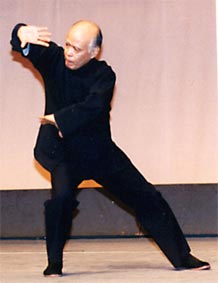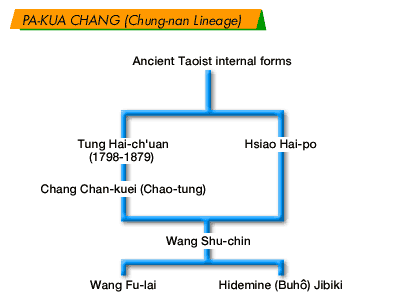Ba Gua Zhang(Pa Kua)
 Ba Gua Zhang(Pa Kua) kua Chang arose out of the ancient Chinese philosophy surrounding the concept of the Eight Trigrams (from the I Ching); together with Tai Chi and Hsing-I Chuan (Xing-Yi), it completes the trinity of 'internal' martial arts.
Ba Gua Zhang(Pa Kua) kua Chang arose out of the ancient Chinese philosophy surrounding the concept of the Eight Trigrams (from the I Ching); together with Tai Chi and Hsing-I Chuan (Xing-Yi), it completes the trinity of 'internal' martial arts.
Legend has it that near the end of the Ch'ing dynasty, Tung Hai-Ch'uan met two Taoist sages deep in the mountains from whom he learned the secrets of the art.
It is known as an art that is practiced by the unique technique of "Walking the Circle," but its true martial applications are surrounded by a veil and cannot be discerned by those who are not students of the art.
Because it is an excellent system of such a high level, students at the AJSSMAF are allowed to begin training in Ba Gua Zhang(Pa Kua) only after they have practiced both Tai Chi and Hsing-I Chuan (Xing-Yi) for a considerable period and have become quite proficient in both arts.
Ba Gua Zhang(Pa Kua) is an internal form whose name means "the palms [based upon] the Eight Trigrams," which suggests that it was designed to allow one to protect one_self even when opponents attack from all directions. Although the actual creator of the art is unknown, old legends state that in 1796 a certain Wang Hsiang of Shantung was taught it to a man named Feng Ke-shan. In 1810, Feng met another master in the art named Niu Liang-ch'en. The orthodox teachings are said to have been passed on by two Taoist 'immortals,' Ku Chi-tzu and Shang Tao-yuan to a youth from Hopei who was practicing austerities on Mt. Omei in Szechwan province. Tung is regarded as the modern father of Ba Gua Zhang(Pa Kua). By defeating the great Hsing-I Chuan (Xing-Yi) master Kuo Yun-shen in a duel, he effected a merger of the two similar systems. To this day, students of the Chung-nan lineage must first master OTC and Hsing-I Chuan (Xing-Yi) before they allowed to practice Ba Gua Zhang(Pa Kua).
Ba Gua Zhang(Pa Kua) is based upon the theory of Yin-Yang and the Eight Trigrams, and its rudiments include "eight palms": 1) standing, 2) carrying, 3) supporting, 4) cutting, 5) piercing , 6) thrusting, 7) grasping, and 8) ox-tongue. In addition, these eight palms are combined in eight basic forms: 1) Single Change of Palm (ch'ien), 2) Double Change of Palm (li), 3) Hawk Soars Up to Heaven (chen), 4) Yellow Dragon Rolls Over (k'un), 5) Snake Sticks Out Tongue (k'an), 6) Giant Roc Spreads Wings (ken), 7) White Monkey Presents a Peach (tui), and Whirlwind Palms (sun). The movement of Ba Gua Zhang(Pa Kua) is basically circular, and it uses mostly horizontal strength and the open palm. The chief exercise of Ba Gua Zhang(Pa Kua) is "walking the circle," in which practitionians seem to be doing but walking around in a circle; what they are actually doing is learning to revolve and rotate-though relaxed, the body becomes like a coiled spring that requires only a touch to set it off. One appropriate image might be that of an invincible dragon that is able to protect it_self from any attack so swiftly that its movement cannot even be seen.







